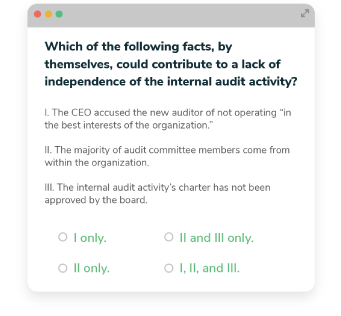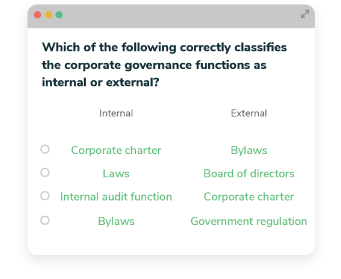Contact Us : 800.874.5346 International: +1 352.375.0772
The goal of the Certified Internal Auditor® (CIA®) exam is to confirm that aspiring candidates have the skills required to perform at the industry’s standards.
CIAs need to be equipped with the skills and know-how to perform their tasks, so the CIA exam is divided into three parts that test a broad range of cognitive abilities.
Aspiring CIA candidates will need to sit for and pass each of these three parts of the CIA exam individually.
Here’s a summary of the exam parts. Further down, we’ll guide you through each part of the CIA exam by breaking down the content tested in each category and subcategory.
CIA Exam Parts | 2019 Syllabus
Part 1: Essentials of Internal Auditing
Part 2: Practice of Internal Auditing
Part 3: Business Knowledge for Internal Auditing
CIA Exam Parts | 2025 Syllabus
Part 1: Internal Audit Fundamentals
Part 2: Internal Audit Engagement
Part 3: Internal Audit Function
The IIA’s updated CIA exam will become testable in English beginning May 28, 2025, and will be released throughout 2025 and 2026 for the additional exam languages.
Due to the staggered release of the upcoming CIA exam changes, the version of the exam you’re taking will depend on when the new exam becomes testable in your chosen exam language.
Although CIA candidates can take the exam in any order, Gleim recommends that most people take the exam in sequential order. Topics in each part build off the previous one, which means that mastering Part 1 will prepare you for Part 2, and mastering Parts 1 and 2 will help you prepare for Part 3.
One notable exception exists for recent graduates. Part 3 tests candidates on topics they need to have professional awareness of, rather than practical knowledge they will use in their everyday tasks. Therefore, many people find CIA Part 3 easier to take while the curriculum is still fresh in their minds.
If you’re not a recent graduate, you’re still welcome to take the exams in any order, but pay close attention to what’s tested on each topic to make sure you’re prepared!
Each of the three CIA exam parts test different topics using multiple-choice questions. There are no essays or free-response questions on the exam.
Candidates have reported that the CIA exam can be tricky and give two very similar answer choices. Always select the best or most correct answer out of the provided options, and if you’re ever in doubt make your best educated guess.
The CIA exam is non-disclosed, meaning the questions on it aren’t available to anyone, including professional review courses like Gleim.
There is a large body of questions that each exam pulls from, meaning no two exams will be exactly the same. The specific number of questions from each topic gets slightly randomized, so it’s important to prepare for all the possible topics that could be on the CIA exam.
CIA Part 1
125 multiple-choice questions
2.5 hours long
CIA Part 2
100 multiple-choice questions
2 hours long
CIA Part 3
100 multiple-choice questions
2 hours long
The The Institute of Internal Auditors® (IIA®) regularly conducts studies in professional environments to understand the responsibilities and expectations of CIAs. This research then informs the CIA exam syllabus, which details what candidates are expected to know, and how well they’re expected to know it.
Each CIA exam part consists of high-level categories (called “domains” in the 2019 syllabus and “sections” in the 2025 syllabus). These categories are divided into subcategories that contain detailed objectives that candidates must perform to pass the CIA exam.
There are two cognitive proficiency levels tested on the version of the CIA exam using the 2019 syllabus:
Regardless of which part of the CIA exam you’re taking, there are a few considerations that apply to all of them.
See the breakdown below of what’s tested on each part of the current exam aligned with the 2019 syllabus compared to the updated exam testing the 2025 syllabus.
CIA Part 1 tests the basics of internal auditing, including fraud and regulatory requirements from the Global Internal Audit Standards.
Part 1 is the longest of the CIA exam parts with 125 multiple-choice questions and an allotted testing time of 2.5 hours.
| Part 1 – 2019 Syllabus Essentials of Internal Auditing |
Part 1 – 2025 Syllabus Internal Audit Fundamentals |
|---|---|
| 1. Foundations of Internal Auditing – 15% | 1. Foundations of Internal Auditing – 35% |
| 2. Independence and Objectivity – 15% | 2. Ethics and Professionalism – 20% |
| 3. Proficiency and Due Professional Care – 18% | 3. Governance, Risk Management, and Control – 30% |
| 4. Quality Assurance and Improvement Program – 7% | 4. Fraud Risks – 15% |
| 5. Governance, Risk Management, and Control – 35% | |
| 6. Fraud Risks – 10% |
The version of the CIA exam using The IIA’s 2019 exam syllabus is testable until May 28, 2025, in English, and will be tested throughout 2025 and 2026 for some of the additional CIA exam languages.
Beginning May 28, 2025, the new version of the CIA exam aligned with The IIA’s 2025 exam syllabus will become testable in English. The new exam will become testable in additional exam languages according to the language release schedule. Note that for the new CIA exam, The IIA’s updated exam syllabus no longer uses the basic/proficient learning specification.
If you want an in-depth look at what’s tested, read our detailed breakdowns of both the 2019 and 2025 exam syllabi below.
Click on any topic below to see the detailed breakdown of each subdomain the proficiency levels.
Click on any topic below to see the detailed breakdown of each section.
CIA Part 2 tests candidates on 100 multiple-choice questions over 2 hours. On Part 2, you’ll be tested on topics related to planning and performing engagements as well as analyzing and communicating about the engagement.
| Part 2 – 2019 Syllabus Practice of Internal Auditing |
Part 2 – 2025 Syllabus Internal Audit Engagement |
|---|---|
| 1. Managing the Internal Audit Activity – 20% | 1. Engagement Planning – 50% |
| 2. Planning the Engagement – 20% | 2. Information Gathering, Analysis, and Evaluation – 40% |
| 3. Performing the Engagement – 40% | 3. Engagement Supervision and Communication – 10% |
| 4. Communicating Engagement Results and Monitoring Progress – 20% |
Click on any topic below to see the detailed breakdown of each subdomain the proficiency levels.
Click on any topic below to see the detailed breakdown of each section.
Part 3 of the CIA exam is 100 multiple-choice questions and candidates have 2 hours to finish it. For the 2019 version of the exam, Part 3 is considered the hardest of the CIA exam parts to pass by many CIA candidates because they aren’t as familiar with these topics as they are for CIA Parts 1 and 2. To add to the difficulty, this section also has the widest range of topics. However, prepared candidates are still able to pass this part on their first try.
| Part 3 – 2019 Syllabus Business Knowledge for Internal Auditing |
Part 3 – 2025 Syllabus Internal Audit Function |
|---|---|
| 1. Business Acumen – 35% | 1. Internal Audit Operations – 25% |
| 2. Information Security – 25% | 2. Internal Audit Plan – 15% |
| 3. Information Technology – 20% | 3. Quality of the Internal Audit Function – 15% |
| 4. Financial Management – 20% | 4. Engagement Results and Monitoring – 45% |
Click on any topic below to see the detailed breakdown of each subdomain the proficiency levels.
Click on any topic below to see the detailed breakdown of each section.
The CIA exam is non-disclosed, meaning the questions on it aren’t available to anyone, and there is a large body of questions that each exam pulls from, so virtually no two exams will be the same.
The exact number of questions from each topic is slightly randomized, so it’s important to prepare for all of the topics to the best of your ability.
CIA exam candidates are instructed to select the best answer out of the given options. Candidates have reported that the CIA exam can be tricky and give two very close answer choices. Always select the best or most correct answer if you are torn between two options.
There are five types of multiple-choice questions found on the CIA exam. You are likely to encounter all five, but due to the non-disclosed nature of the CIA exam, your experience may be a little different. Don’t worry. As long as you’re prepared, you can easily answer anything the CIA exam throws at you.
Be on the lookout for absolutes during your exam. Questions or answers with words like always or never can often be solved by asking yourself “are there any exceptions?” If so, you’ll know if an answer is more or less likely to be correct.
In the new version of the CIA exam, there will no longer be negative questions or questions two or three combined answer options.

